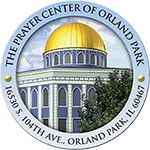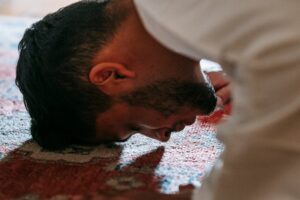How did Makkah emerge on the socio-religious map of the world?
Are the rituals practiced during Al-Hajj the response to the prayer of Ibrahim and Ismail?
What is the journey of Al-Hajj? Is it a mere ritual or a comprehensive way of Life?
The objective of this article is to show you that the rituals of Al-Hajj correspond closely to the day-to-day social actions and practices expected from us.
Al-Hajj reminds us of Ibrahim, Hagar, and Ismail in a dry, waterless valley without cultivation, surrounded by barren mountains and the desert. In a valley without cultivation, the symbol of extreme hardship and absence of life, we find a young woman breastfeeding her infant-child, the symbol of extreme human weakness. Ibrahim, Hagar, and Ismail are teaching the human being an important lesson: Do not despair, and do not give up hard work. For Allah has installed in you the potentials and the capabilities to overcome your weaknesses and make life possible. Ibrahim, Hagar, and Ismail are saying: You can build a city in a valley which apparently has no life, and you can create a new culture – culture is the best English translation of Umran, growth and development. Umran reminds us of Umra, the shorter Hajj.
The journey to Arafa reflects the drama of the human being. Arafa is at the heart of Al-Hajj, as Prophet Mohammad said: Al-Hajj is Arafa. Ibrahim is the architect and the designer of this journey. He prayed to Allah to show him and his descendents the rituals as landmarks along the journey and the places to walk upon towards the Truth. “And show us our places for the celebration of due rituals.” [2:128]
The rituals of Al-Hajj constitute the blueprint or the prototype that orders our life. A contemporary Muslim scholar said: “If Quran is Islam in words, Al-Hajj is Islam in movement.”
The journey starts by making our intention to perform Al-Hajj clear and explicit. We declare our awareness of Allah and what we are doing, of ourselves and the people around us. The other word for rituals is “sha’ir” which literally refers to consciousness. We know the address and the direction. The road map is obvious and transparent. Nothing is secret about it. Like the message itself, it should not be concealed. The call for Hajj is made in the open, and every effort is made to make the call well heard and well answered. We are ready to move with the crowd to the summit with the resolve to establish in ourselves a state that is compatible with the summit: No obscenity, no wickedness, and no wrangling. It is the state of “ihram” that values and preserves life and the quality of life. Pilgrims actualize “ihram” in their character and behavior compatible with al-haram, the Sacred House of Allah. We are the actors and the spectators at the same time. We are actively engaged, and we are the heroes of the story. We are in harmony with the people around us wearing simple white garments without special signs, ornaments or patterns. One becomes all, and all becomes one. The path is shared, the enemy is common, and the destiny is one. Nothing will save them except “Tawaf” and what it symbolizes. Tawaf aims at the mutual recognition among the diverse cultural experiences in order for the life of the people to be perfected.
Collectively, they compass around Ka’aba, the Qibla, a tangible landmark that validates that they are on the right path towards Allah, the ultimate goal and “qibla.” This is the time for them to embrace Ka’aba, forming a human shield around it. They compass around it seven times, the number that signals the continuous and spiral struggle to achieve what is better and higher after each round, and in harmony with the seven heavens of this ever moving and expanding universe. Thus, tawheed: the belief in one God in its deeper and cosmic meaning is manifested in the unity of the people and in their unity with the universe.
This struggle at the vertical dimension starts from the black stone located at the Shami corner of Ka’aba facing Bait Al-Makdis in Jerusalem. From that point, the people should start their mass movement towards Allah, realizing their collective perfection as one Ummah.
The vertical struggle is coupled with another form of struggle at the horizontal dimension: Sa’y between Safa and Marwa. Running between the mountains of Safa and Marwa is reminiscent of the patient search of Hagar for water. Sa’y is the daily struggle for life and the quality of life. It starts from Safa, the symbol of purity and cleansing, reaching for Marwa, the symbol of water and life. Finding water should not stop our search but should take us back to Safa. It is another spiral movement as the name of Hagar indicates: a hegira from the state of being to the state of becoming, a hegira from clay towards Allah, a hegira that enabled the early emigrants of a qualitative return to Mecca for Hajj.
This struggle in its vertical and horizontal dimensions is the most balanced struggle that will inevitably produce a new kind of people looking for a new horizon, and searching for, grasping and knowing Arafa, the summit and the apogee. There, we pray for forgiveness as the crowd is reminiscent of the day of reckoning and judgment. The summit is not the end, and should not be the state of realization that may stifle the engine that initiated the movement; but a summit that reminds us of the continuous approach to Truth, and the responsibility and accountability that do not cease.
Now we have reached the summit and discovered ourselves in relation to Allah. We passed the test and our wish has come through. We come down from the summit with the spirit of the summit and the perfection of the hereafter to perfect our actions since we are still in this life, the place for investment for the next life. We come down to Mina, which literally means wish, destiny or fate. We can declare victory over evil and the evil one, Satan. We throw pebbles at him. (Jamarat are literally burning pieces of clay) He cannot say any more. “I am better than him; You created me from fire and created him from clay.” [38:76] We are symbolically beating him with clay and fire.
This victory deserves celebration. But how do we celebrate? By sacrifice, by giving from ourselves to others, a gift that has realized its time and place. “Until the offering reaches the place of sacrifice.” [2:196]
We are ready to give and to give big. “When they are down on their sides, eat you thereof, and feed such as live in contentment, and such as beg with humility.” [22:36]
A free and honored human being is reborn who is not offered anymore after Ibrahim and Ismail as a sacrifice but ransomed by His Caring and Compassionate Creator with a momentous sacrifice. “And We ransomed him with a momentous sacrifice.” [37:107]
Al-Hajj is the model for people to know how to live their life and order their life, to know how to reach the summit together while keeping Allah as their Qibla and their destination, and to know how to sacrifice and give generously to others.
By Dr Walid Khayr




